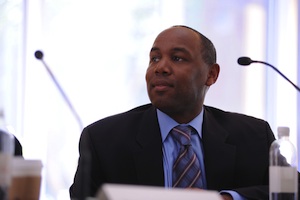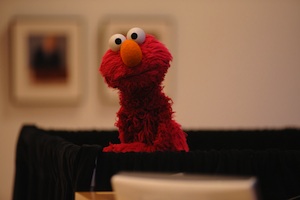 Last week I had the chance to head back to my home turf to attend the “Media and the Well-Being of Children and Adolescents” conference at the Annenberg Public Policy Center (APPC) at the University of Pennsylvania. The conference was organized, hosted, and moderated by Dr. Amy Jordan, director of the Media and the Developing Child sector of APPC and Dr. Dan Romer, director of the APPC’s Adolescent Communication Institute. The day featured informative and engaging presentations by some of the nation’s top leading researchers, scholars, and practitioners.
Last week I had the chance to head back to my home turf to attend the “Media and the Well-Being of Children and Adolescents” conference at the Annenberg Public Policy Center (APPC) at the University of Pennsylvania. The conference was organized, hosted, and moderated by Dr. Amy Jordan, director of the Media and the Developing Child sector of APPC and Dr. Dan Romer, director of the APPC’s Adolescent Communication Institute. The day featured informative and engaging presentations by some of the nation’s top leading researchers, scholars, and practitioners.
Though the subject matter of the morning panel presentations varied greatly, their underlying theme was consistent: content counts! Convergence in the research evidence indicates that kids do learn from all kinds of media; however, the nature of how and what they learn reflects the nature of the media that they see and interact with. As such, the day’s dialogue began with issues of concern regarding the relationship between media exposure and the health and behavior of youth. Dr. Dina Borzekowksi (Johns Hopkins) discussed the links between exposure to unrealistically thin images in the media and adolescents’ body dissatisfaction and disordered eating, while Dr. Sonya Grier (American University) commented on the barrage of food marketing directed at kids and the implications of those messages for the current child obesity epidemic. Understanding and combating the influence of food marketing, or any other negative messages, urged Dr. Grier, requires consideration of the combination of the frequency, content, and context of kids’ exposure to them. Dr. Victor Strasburger (University of New Mexico) and Dr. Craig Anderson (Iowa State University) described the state of the literature regarding relationships between media exposure and alcohol/drug use and aggressive behavior, respectively. Finally, Dr. Jane Brown (UNC Chapel Hill) rounded out the panel with a discussion of media’s role as a “pseudo-peer” and its influence on adolescents’ sexual behavior.
A particularly lively conversation about the usefulness of media literacy training emerged following the presentations; panelists and audience members alike debated whether media literacy training helped inoculate kids to potentially harmful media messages, or taught them to pay more attention to the messages thereby potentially heightening unfavorable effects. Agreed upon by all was the need for more — and more rigorous — research on the protective effects of media literacy training for youth.
The researchers on the second panel reminded us that the influence of media is by no means always negative. Dr. Dafna Lemish (Southern Illinois University) shared highlights from her research on how media can help children who are experiencing major conflict in their daily lives, such as war or natural disasters, by informing them, relieving their tension, and keeping them busy and out of harm’s way. Dr. Michele Ybarra (Internet Solutions for Kids) described some of the international health interventions and evaluative research she has conducted with youth to lower their risk of HIV. Jim Multari described several on-going initiatives at Sprout aimed at promoting parent-child interaction and “one million acts of kindness” (check out their website to watch the count; currently over 140,000 acts of kindess from kids have been reported). A presentation from Dr. Ellen Wartella (Northwestern) focused on the large and ever-growing body of research indicating that children learn academic knowledge from well-designed educational media, as well as pro-learning attitudes and behaviors that can have particularly strong and lasting positive effects.
 The third panel of the day took the research a step further, as this batch of presenters discussed implications of research for media practitioners. Picking up the theme of the earlier panels, their presentations focused on strategies for maximizing the positive potential and minimizing the risks of unfavorable influence of traditional and newer media platforms and content. Dr. Jeanette Betancort (Sesame Workshop) explained the “Sesame model” as it pertains to educational outreach programs like the military families initiative. After deciding on a particular child need to focus on, chosen based on child development science and/or current events in society (e.g., large military deployments), Jeanette’s team forms and convenes an advisory board of experts, and then conducts formative focus group research with English- and Spanish-speaking families. With the information gleaned from this process they design outreach materials and then conduct summative research to ensure that their efforts are meeting children’s needs.
The third panel of the day took the research a step further, as this batch of presenters discussed implications of research for media practitioners. Picking up the theme of the earlier panels, their presentations focused on strategies for maximizing the positive potential and minimizing the risks of unfavorable influence of traditional and newer media platforms and content. Dr. Jeanette Betancort (Sesame Workshop) explained the “Sesame model” as it pertains to educational outreach programs like the military families initiative. After deciding on a particular child need to focus on, chosen based on child development science and/or current events in society (e.g., large military deployments), Jeanette’s team forms and convenes an advisory board of experts, and then conducts formative focus group research with English- and Spanish-speaking families. With the information gleaned from this process they design outreach materials and then conduct summative research to ensure that their efforts are meeting children’s needs.
 Dr. Kevin Clark (George Mason University) discussed his work teaching high school students to design their own educational video games for the National STEM Challenge. Notably, he reported increased math and science games among these students after two years of participation in his program. Dr. Clark stressed that interventions like training in video game design should not be considered a “one-time thing,” but rather should be on-going to find maximum impact. He emphasized further that children’s and adolescents’ own agency in creating the games is a really powerful learning mechanism, especially when there is a specific goal for their created projects, like submission to the STEM Challenge.
Dr. Kevin Clark (George Mason University) discussed his work teaching high school students to design their own educational video games for the National STEM Challenge. Notably, he reported increased math and science games among these students after two years of participation in his program. Dr. Clark stressed that interventions like training in video game design should not be considered a “one-time thing,” but rather should be on-going to find maximum impact. He emphasized further that children’s and adolescents’ own agency in creating the games is a really powerful learning mechanism, especially when there is a specific goal for their created projects, like submission to the STEM Challenge.
 Our own Executive Director, Dr. Michael Levine presented on this panel as well, and discussed the importance of child development models that consider children’s whole social ecology as well as the need to extend these models into the modern digital age. To this end, he presented Cooney Center findings regarding the ability of well-designed digital media platforms and content to reunite generations, and how the Center is conceptualizing the “new co-viewing” through initiatives like our e-book line of research.
Our own Executive Director, Dr. Michael Levine presented on this panel as well, and discussed the importance of child development models that consider children’s whole social ecology as well as the need to extend these models into the modern digital age. To this end, he presented Cooney Center findings regarding the ability of well-designed digital media platforms and content to reunite generations, and how the Center is conceptualizing the “new co-viewing” through initiatives like our e-book line of research.

A final highlight of the event was an award ceremony during which Rosemarie Truglio, Melvin Ming, and Elmo accepted on behalf of Sesame Workshop the APPC’s “Award for Excellence in Children’s Media.” The Workshop received accolades for over 40 years of educating and entertaining children through the “Sesame Model”. These tributes came from the APPC hosts as well as esteemed scholars Dr. Dan Anderson (University of Massachusetts Amherst) and Dr. Sandy Calvert (Georgetown). Naturally, Elmo stole the show, and perhaps the Annenberg Public Policy Center will even take his advice and rename their institution “Actors Playing Polite Chickens”… I think it has a ring to it.
All photos courtesy of ASC.


